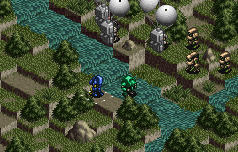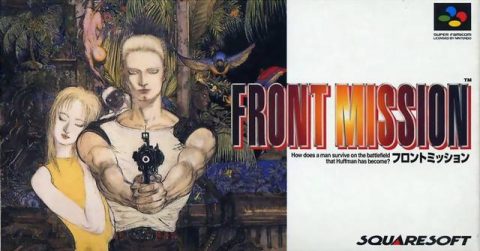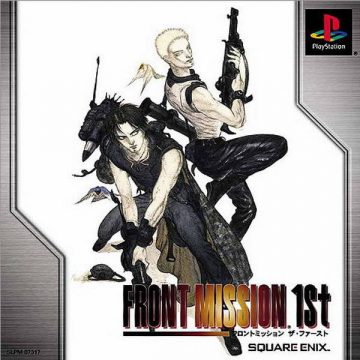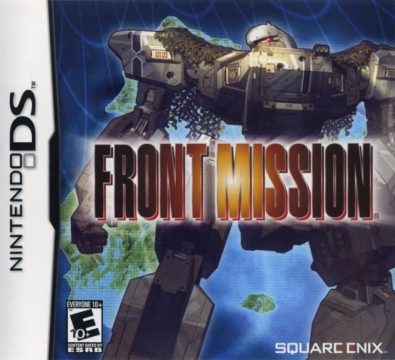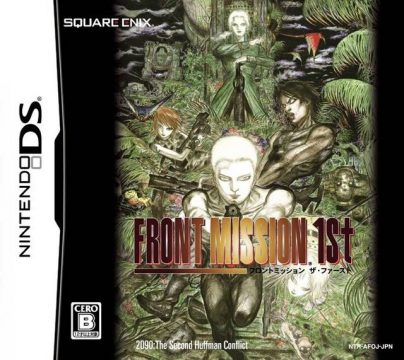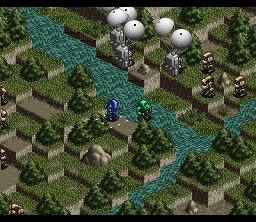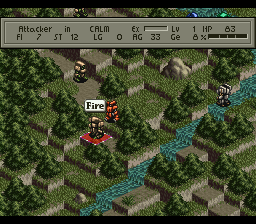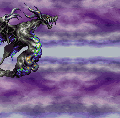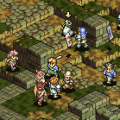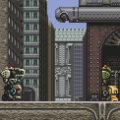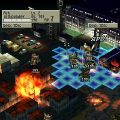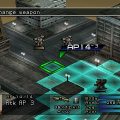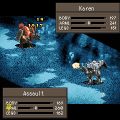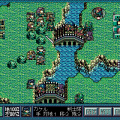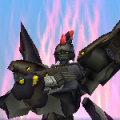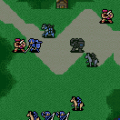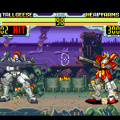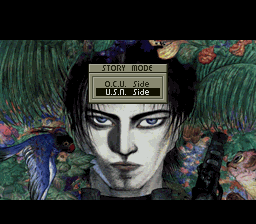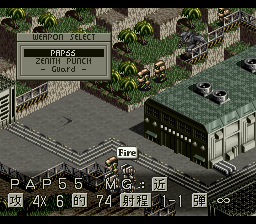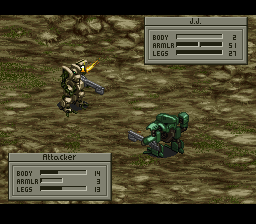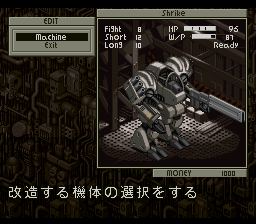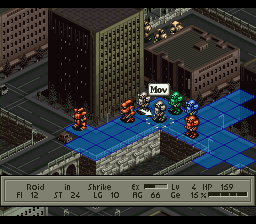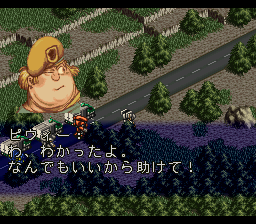Front Mission is Square’s first true turn-based strategy role-playing game (RPG) series, and is currently handled by Square Enix Product Development Division 6 (PDD6). Created in 1993 by series visionary, Toshiro Tsuchida (the current head of PDD6), the series made its debut on the Super Famicom in 1995 with Front Mission. Ever since then, the series has enjoyed the release of many other titles as well as a large stock of merchandise in Japan. While not as popular as Square’s other flagships like Final Fantasy, the series has earned a very loyal audience that supports it unquestionably. This success however has not transferred overseas and it is partially due to Square USA’s poor handling of the series. Only four installments have seen release in the West: Front Mission 1st, 3, 4 and Evolved. As a result, many outside of Japan will never be able to truly appreciate the series in its entirety.
Inspired by Intelligent Designs’ Fire Emblem series, Front Mission plays out in turn-based strategy, though several spin-offs have been created throughout its 15 year history. What makes it different, however, is its usage of mecha (called “wanderpanzer” or “wanzer,” German for “walking tank”) and how it affects game mechanics. Wanzers are modeled after the “real robot” mecha archetype, being a versatile war machine that is used alongside other military weapons. One of the biggest draws is the customization aspect. The player is able to customize a wanzer from its parts, auxiliary backpacks, weapons, and even paint schemes. The incredible amount of customization can be addictive, but also daunting to those who are not into micromanaging their games. It’s very comparable to From Software’s Armored Core series in this sense so those who have played those games will feel right at home with Front Mission.
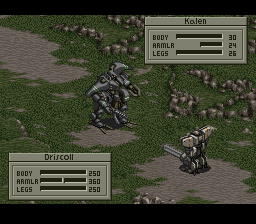
Super Famicom
In battle, the uniqueness of the wanzer is also displayed; a wanzer’s performance is dictated by its four parts: a body, two arms, and the legs. Destroyed parts reduce a wanzer’s ability to fight; blow off its legs and it can’t move or evade attacks. A lost arm means that it can’t use any weapons it has equipped. Take out the body and the wanzer is destroyed. Combat is similar to other genre offerings in that it takes place on isometric 2D (in Front Mission) or 3D grid maps. When a battle initiates, the action zooms into a close-up of the map that shows the wanzers fighting. While battles were modeled initially after Fire Emblem, it has evolved dramatically since the first game. Action Points (AP) were introduced and dictate how many actions a unit can do on their turn. Melee, ranged, and artillery weapons that acted in a rock-paper-scissors manner became true melee, ranged, and artillery weapons with their own unique qualities. Eventually, squad-based combat and friendly fire made its way into the series, giving it a tremendous amount of strategic depth and variety.
Game mechanics aside, Front Mission‘s true strength comes from its design and story elements. The biggest design influence is the series’ grounded realism; the setting is based off of near-future trends of how our world will evolve. For example, the technology of the series has real-life applications. Front Mission‘s cast of characters come from all over the world, from Venezuela to Korea to even Iceland. In terms of game design, each game differs in how it’s meant to be played and these result from the atmosphere and story direction. For example, the player is thrown into all-out wars in Front Mission 2 as it takes place during a coup d’etat. Its art and music direction are gritty and depressing, fitting for the game’s storyline. A notable trend in terms of art and music is that artists and composers differ amongst the games. Artists and composers of the series include Yoshitaka Amano, Yusuke Naora, Yoko Shimomura, and Hidenori Iwasaki. Despite the lack of a true representative in art and music (Naora and Iwasaki could be considered such for art and music, respectively), all elements in each game come together to form a greater cohesive whole.
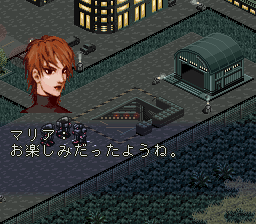
PlayStation
In terms of story, Front Mission is modeled after serial dramas, much like the TV serials 24 and Lost. While each game has a self-contained story, they also interconnect with the other entries. Newcomers can jump into any game due to the self-contained story, but will miss out on the bigger picture. The interconnected stories also exist to provide a cause-and-effect relationship for major events; what happened in one Front Mission affects events from another. Accompanying these events is a large recurring cast of characters, adding considerable depth to the stories. While the video games’ storytelling focus is more world-driven, the expanded universe supplements’ (detailed further in the article) character-driven focus balances this out. So like any serial drama, only those who stick with Front Missionfrom the start will get the most out of its storyline.
The stories of the series revolve around supranational unions and the conflicts between them in the 21st and 22nd century. Most involve the Oceania Cooperative Union (OCU) and the United States of the New Continent (USN/Unified Continental States or UCS in the official English localizations), though other unions such as the European Community (EC), Organization of African Consolidation (OAC), and the Republic of Zaftra take part as well. In keeping with the series’ near-future roots, each game focuses on particular military, political, scientific, and philosophical themes that form the core of their stories. For example, a major recurring theme in the games is the struggle between globalization and nationalism.
Developed by G-Craft (Arc the Lad), the company Tsuchida and his colleagues founded after leaving NCS/Masaya (Assault Suits Valken, aka Cybernator in Konami’s English release), the original Front Mission was published by Square for the Nintendo Super Famicom in 1995.
In 2090, an OCU recon unit is sent to investigate a USN munitions factory on an island called Huffman Island. The investigation spirals out of control when the unit is ambushed by USN forces, which destroy the factory. This incident, later known as the Larcus Incident, results in the outbreak of the 2nd Huffman Conflict when diplomatic talks between the OCU and USN fail.
OCU Characters

Roid Clive
The main male protagonist, Roid is an OCU captain who gets involved in the Larcus Incident. His fiancee, Karen Meure, is killed during the Larcus Incident. He joins the Canyon Crows mercenary group upon meeting OCU colonel Guri B. Olson, who promises him the chance to find the pilot who killed Karen. Called Royd Clive in the official English localization, Lloyd Clive in the unofficial one.

Ryuji Sakata
An OCU soldier and friend of Roid’s, Ryuji was also involved in the Larcus Incident. He tried to return to Japan after being dismissed from the army, but couldn’t do it out of shame. Ryuji is the son of Reiji Sakata, who is the head of Sakata Industries, a conglomerate that produces medical and wanzer technologies.

Natalie Blakewood
The main female protagonist, Natalie is an OCU lieutenant and the adjutant for the Canyon Crows. She is the daughter of Willas E. Blakewood, a brigadier general who also oversees the Canyon Crows. Her father Willas objects to her involvement with the Canyon Crows and military life in general.

Driscoll
A USN captain, Driscoll is the instigator of the Larcus Incident. He ambushes Roid’s unit, and sets them up to take the fall for the incident. Driscoll is also the head of a USN R&D division known as the Nirvana Institute. Although no one knows his true motives, he seems interested in inciting the fires of war…
The art direction, done by Yoshitaka Amano of Final Fantasy fame, is an odd choice for Front Mission. While the character art does seem out of place in the near-future settings of the game, it provides a good contrast with Kow Yokoyama’s (Maschinen Krieger) art direction for the wanzers. In fact, players of the earlier Final Fantasies might get certain vibes from the character design. The rest of the graphics is good and portray the settings well, even if they could use a tune-up. The battles are more detailed than the rest, especially the combat sequences. The music composed by Yoko Shimomura (Kingdom Hearts) and Noriko Matsueda (The Bouncer) provides an intriguing contrast of styles, from Shimomura’s catchy tunes such as “Manifold Irons” and Matsueda’s atmospheric tracks, like “Ominous”. The sound effects are nothing special, but the “bopping” sound of the wanzers moving is worth noting.
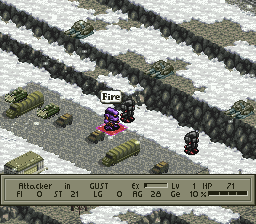
PlayStation
Being inspired by Fire Emblem, the original Front Mission plays very similar. The player gets a large cast of characters to use in battles, which are played out with a rock-paper-scissors system similar to the game it’s influenced by. Melee weapons excel at destroying wanzers, but are beat out by ranged firearms, which have attack priority and hit first. Long-range artillery like missiles has the range advantage, but possesses finite ammo and cannot be used up close. Each character gains proficiency based on the type of weapon they’re using, which is used to unlock skills such as the ability to manually target enemy parts. Apart from this, there are items that help wanzers in fighting their enemies. (Chaff reduces missile accuracy) The player can also use a supply truck, which provides support to ally units. Briefings, which show data about upcoming missions (albeit in a rather bland screen), also exist to aid players.
The original Front Mission is an excellent game, but it has a number of flaws that hamper the overall experience. Game balance is lacking in a lot of ways, especially in weapon balance. Despite the rock-paper-scissors setup, ranged firearms and artillery dominate the game. Ranged firearms, with skills, can decimate any enemy in one attack. Long-range artillery is essentially free damage and can be relied upon thanks to the supply truck. As a result, melee weapons and specialists are not really worth using. Front Mission has an uneven difficulty curve; there is no tutorial system and the first few missions can frustrate those not used to the genre. In addition, the game doesn’t offer much in the way of playability; aside from the Arena (where players can make money), it’s all missions. Skills also can’t be removed, which limits a character’s roles. The interface also takes some time to get used to as well.
The Super Famicom version is Japan-only, even though Square had planned on bringing it to the West, alongside other titles like Bahamut Lagoon. However, a team of series fans developed an unofficial English localization on 2001, thus making it playable in English. This unofficial localization was also brought up at E3 2007 during the presentation of Front Mission 1st on the DS (detailed further in this article) to producer Koichiro Sakamoto. Sakamoto acknowledged the work and commented that he would like to give something back to the fans as a result. On a final note, Front Mission was also ported to Bandai’s Wonderswan in 2002. This is a complete port with no additions or changes made to the game. It actually looks pretty good, even though the viewable screen area is much smaller, and the background turns entirely black when you try to move. The music has been obviously downgraded a bit too, but still sounds pretty decent.
In 2003, a port of the original Front Mission was made for the Sony PlayStation, titled Front Mission 1st, as part of the new Front Mission Project line. The defining feature of this remake is the inclusion of a second scenario for the USN side. This new scenario explored unresolved plot elements from the OCU scenario and thereby explaining what really happened during the 2nd Huffman Conflict. The new scenario was also used to bridge the gap between Front Mission and Front Mission 4, the latter of which is a continuation of on-going stories from the former.
USN Characters
Kevin Greenfield
The main male protagonist of the USN story, found only in the PSOne and DS games, Kevin is a USN lieutenant and a member of the Black Hounds assault unit. He was the leader of the Bravo team with the Black Hounds, but was relieved of his duties after botching up an operation in the Andes Mountains.

Maria Paredes
The main female protagonist, Maria is a USN captain and a member of the Black Hounds. She was the leader of the Alpha team with the Black Hounds and possesses exceptional combat abilities. Maria’s past, even her military history, is largely unknown and she rarely brings it up in conversations.
Despite the addition of a new scenario, Front Mission 1st is largely the same as the original game. Yoshitaka Amano returns to supply new artwork for the USN scenario, but Yusuke Naora (Unlimited SaGa) makes his debut with the USN scenario. In contrast to Amano’s fantasy-based style, Naora’s realistic artwork is a stronger fit for the scenario and the game as a whole. The backgrounds are also redrawn and look more visually detailed than the original. Hidenori Iwasaki also makes his debut as the composer for Front Mission 1st. Iwasaki’s work here involved arrangements of the original tracks, as well as new compositions for the USN scenario. The arrangements are a welcome change; most of the original tracks sound a lot better than before.
Art and music aside, the USN scenario takes its inspiration from the games that came after the original Front Mission. The end result is a better, balanced and engaging campaign. Story and character development are major improvements from the OCU scenario; it’s well written, the pacing is good, and most importantly, it has character development. Whereas only Roid and a few others had character development in the OCU scenario, everyone on the USN side gets a fair share of treatment. Game balance is also better, with less abrupt difficulty spikes than the OCU scenario. There are new parts and weapons, such as repair backpacks, but these are minor additions. This PlayStation version of Front Mission has neither received an official nor an unofficial English localization.
Using leftover funding from the Front Mission Project, Front Mission 1st was ported to the Nintendo DS in 2007. Aside from touch screen functionality, the game is largely the same as its PlayStation counterpart. This version does, however, have a number of additions that make it the definitive version of the original Front Mission. The most notable of these additions are new missions on both scenarios, and retroactively-added recurring characters from other episodes to better tie-in the series’ on-going stories. Other additions include new parts, weapons, and difficulty settings. The touch screen controls are passable, but the small menu options make it hard to use at times. This version was released in both Japan and North America, making it the only version of Front Mission 1st to receive an official English localization.
Screenshot Comparisons
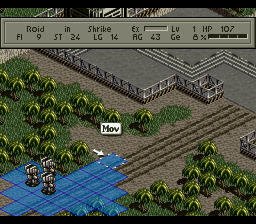
Super Famicom
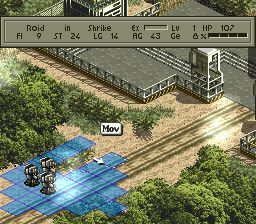
PlayStation
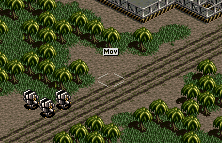
Wonderswan
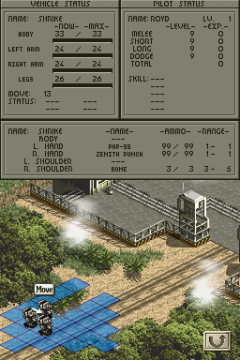
Nintendo DS
Forgotten Heroes of Gaming – Peewie Richberg Jr.
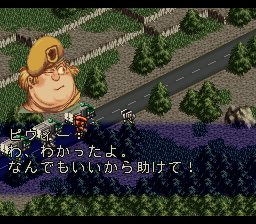
Peewie is one of the most bizarre-looking characters to appear in a video game, especially one as series as Front Mission. He’s meant to be the comic relief (obviously), apparently always has one eye closed and barely has a neck, but he also serves an invaluable purpose – he drives the supply truck that appears in many missions, which is vital to restocking and repairing your wanzers. And since his truck is almost defenseless save for some weak machine guns, you’ll need to do your best to protect him. Sure, he’s pretty atypical of your usual RPG pretty boy, but fat sweaty truck drivers need your respect too!
